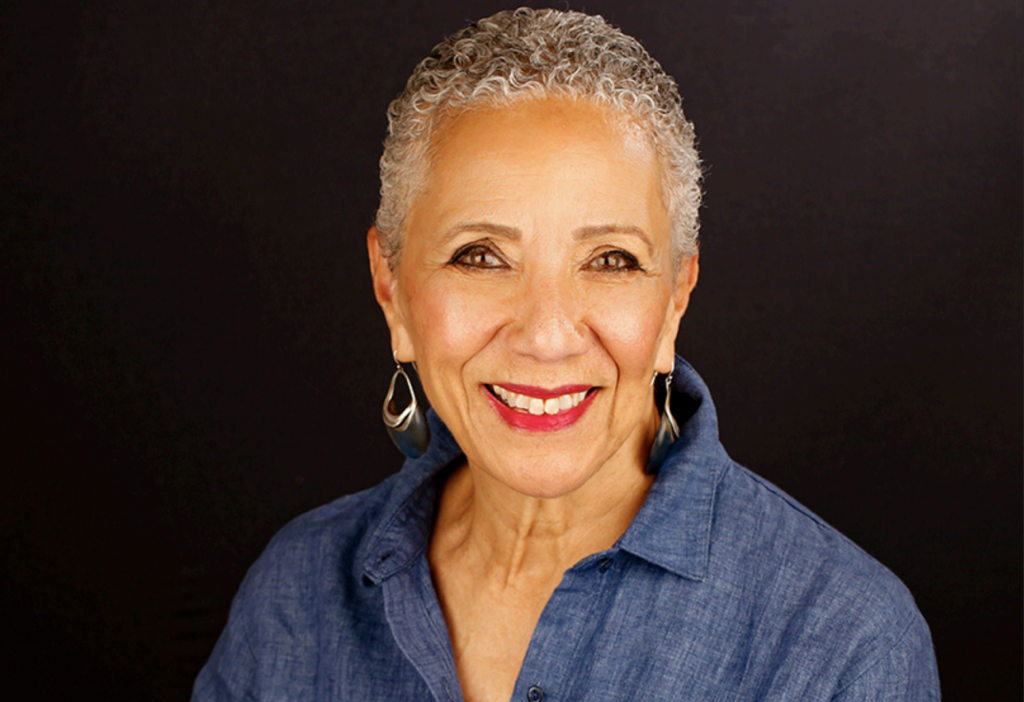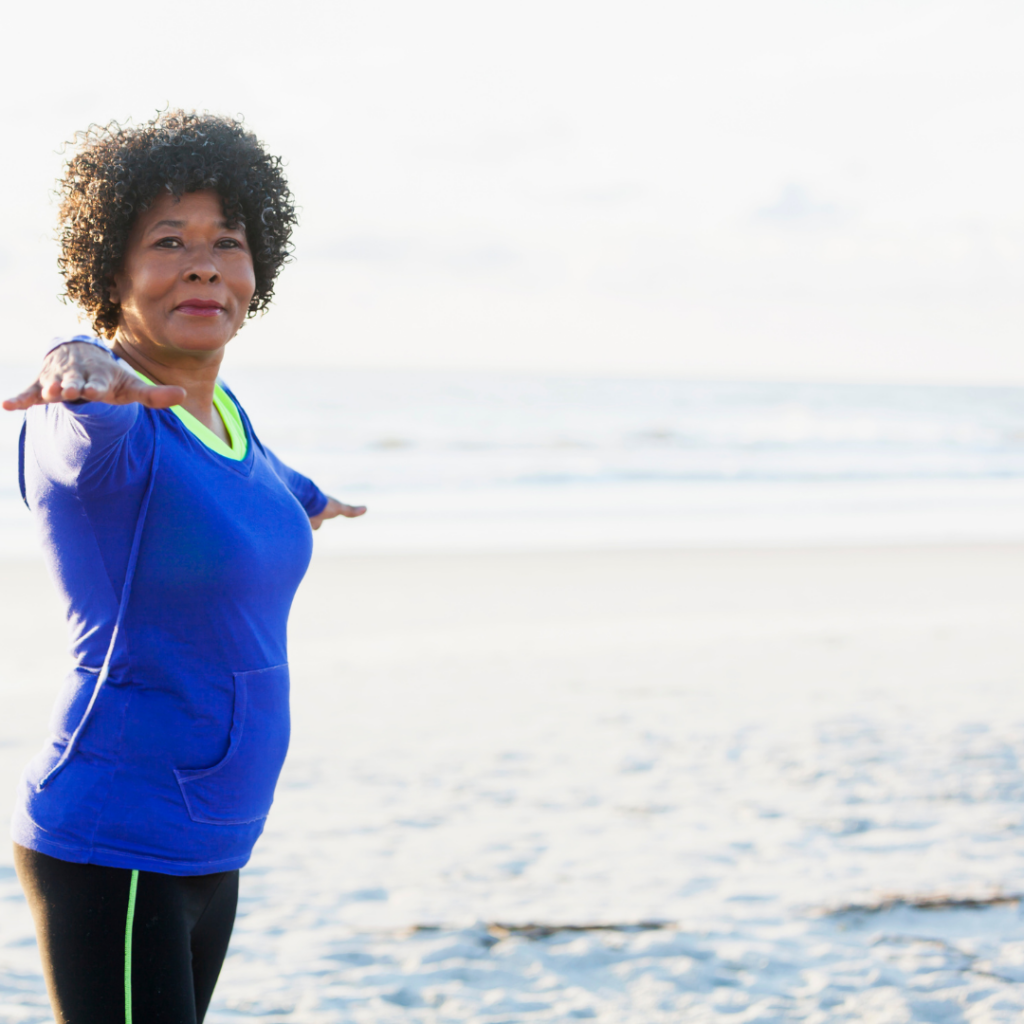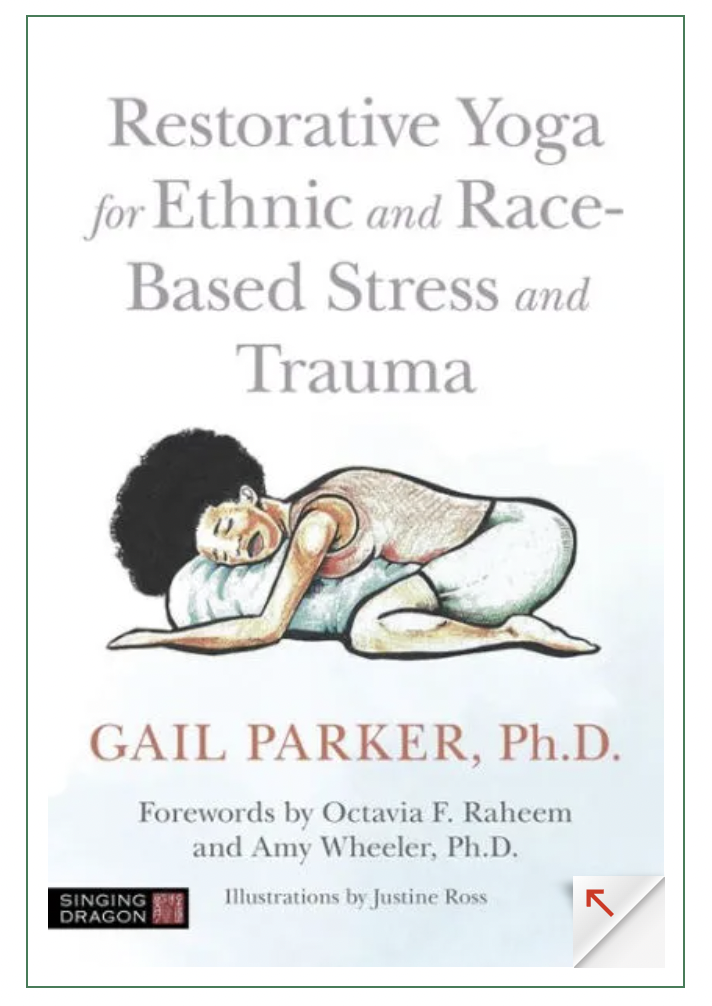REST AND RESTORATION

Speaking via Zoom from her home in Palm Springs, CA, Dr. Gail Parker, Ph.D., C-IA YT, E-RYT 500, seems as calmly gracious as an opening lotus, with no visible indication of the tangled, murky depths below the floating blossom. A yoga therapist educator, she serves as President of the Black Yoga Teachers Alliance (BYTA) Board of Directors and has been a practicing psychotherapist for more than 40 years.
But unlike the athletic, aerobic, and downright acrobatic trend in Western yoga, Dr. Parker’s practice centers on restorative yoga which focuses upon stillness as a powerful element in recovery from the centuries-deep effects of ethnic and racial stress and trauma. Restorative yoga doesn’t rely on muscular engagement or quick changes from asanas (positions), but instead engages the practitioner in near or complete silence and semi-darkness, supporting the body with bolsters, blocks and cushions on the floor. “This allows you to hold a posture for extended periods of time,” explains Dr. Parker, “and this engages the parasympathetic nervous system, which signals us to rest, digest, and relax.”

Relaxation, however, is not a state of forgetting. In the gentle setting of restorative yoga, long-buried sensations will surface. “Ancestral memory is real,” she says. “In my fellow African Americans, the evidence of the past, meaning genocide, enslavement, dislocation, colonization, and stripping of language and identity, is evident in what’s called High-Effort Coping. We learn from infancy that in order to get half as far, we have to be twice as good. We are taught that we have to be 200% better than our peers who are not Black. The trope of the Strong Black Woman who can endure anything is an example of this High-Effort Coping style, which ultimately wears us out, wears us down. It’s exhausting.”
Dr. Parker cites the groundbreaking work of Black health researcher and epidemiologist Dr. Sherman James as an influence upon her study and life. James is known for his landmark studies of the debilitating effects of generational racism to which he referred as “John Henryism.”
The classic folk ditty John Henry describes the nearly-superhuman strength of that steel-driving’ man who raced against a steam-powered rock-drilling machine, saying “A man ain’t nothin’ but a man, / But I’ll die with my hammer in my hand.” He drove so hard that he broke his poor heart, but John Henry had a little woman, her name was Polly Anne, and Polly Anne drove steel like a man, Lawd, Lawd — and so the archetype of the indomitable, Stoic Black woman is enshrined in a song that initially seems to celebrate Black resistance and resilience. James concluded, among other things, that the relatively short lifespan of Black men had much less to do with their genes than with the surrounding social environment. This theory helped shape the discussion about the role of the social determinants of health in affecting the longevity of Black Americans.
She also references the book Of Water and the Spirit by Burkina Faso-born healer, teacher and author Malidoma Patrice Somé, who recounts his return to the sacred healing traditions of his Dagara culture after being indoctrinated into European Christian theologies at a Jesuit mission school he was forced to attend. Just as with the late Somé’s re-initiation into his nearly-erased legacy of indigenous and ancestral medicine ways, Dr. Parker explains that Black people can begin the process of releasing trauma by learning to rest.
Fifty Nifty and More

Instructions
- Visit Redeem
- Enter (your code) into the box and click ‘apply’
- Create an account (email address and password required).
- Click ‘Proceed’.
- Click on resource in ‘My Library’ to read (make sure to click on the cover rather than ‘details’, as clicking ‘details’ will return you to the home page).
- Once the book is added to ‘My Library’, you can also access it on your mobile device by downloading the JKP Library App (available on Google Play or the Apple App Store).
“In many ways, this world is inhospitable to Black people, and has been so for a very long time,” she says. “Remember that if you were Black, and were considered the master’s property, you could be killed for resting! The racist trope of laziness pursues Black people into the modern age. The result is that we always show up at 200%.” The intergenerational impact of centuries of oppression, she explains, goes beyond the specific experience of individuals to affect entire communities, often on a deeply unconscious level. While unrecognized, the trauma often makes itself known through troubling habits and behaviors which may also be present in other family and community members.
“The wounding is so profound that you can’t just walk around in the world and function, so many of us tune it out. We shut down and suppress emotion so we appear stronger, and this is a maladaptation that robs us of our inner peace. We are carrying an injury that can’t healed on its own. And so our panic attacks, outbursts, melt-downs, flashbacks, headaches, backaches, depression, hypertension, insomnia, self-blame, addictions, eating disorders, self-sabotaging behaviors and other common reactions are not pathologies here, but they are the result of hyper-vigilance, a necessary adaptation to living in an inhospitable world. They are legitimate responses to painful injuries that are our legacy, further activated by active wounding out in the present world today. But it is to our advantage to allow our true feelings to surface, and to begin to disarm and release them.” The “re-surfacing” will often begin with strong physical sensations which have been denied and pushed down for multiple lifetimes.
What makes the cumulative experience of racial, generational trauma challenging is that the majority society gaslights us and tells us we’re crazy. “We’re not crazy, we’re hurt. Being hurt is not mental illness, and we don’t have to ‘get over it’,” says Dr. Parker. “First, we need to become aware. Awareness is the heart of my yoga practice. I’ve been doing yoga all my adult life, and I didn’t start with yoga postures. That’s not the yoga I’m talking about. Before there was a yoga studio in every pod mall, yoga was taught as a philosophy, not as a sport. This approach cultivates the mind not as storehouse of information, but a tool of awareness.”
She shares a funny moment when even she herself did not see the obvious. “I was in Las Vegas, at a performance by Siegfried and Roy. I didn’t see any tigers. There’s no doubt that there were tigers on the stage! I carry this memory with me as an example of how all of us are sometimes blind to the obvious.”

Conscious breathing is key to the restorative yoga transformation: blood pressure drops, heart-rate slows, metabolism slows, respiration becomes more efficient, and brainwaves alter, allowing the body to begin the healing process. “We want to become emotionally articulate. We need to ask ourselves, what am I angry about? What am I afraid of? What do I want? The answer to this last question is universally the same: I want to be safe, loved, cherished and seen.”
And after centuries of resistance and High-Effort Coping, rest is a necessity to fully support healing. “Rest is your superpower,” says Dr. Parker.
Working with a skilled practitioner who utilizes restorative yoga to address trauma is often a helpful path, versus talk therapy alone. Seek out a yoga therapist who specializes in trauma-informed yoga. For instance, in this sort of treatment, you will be one-on-one with the therapist, since most group classes do not yet offer trauma-informed practices.This will be more comfortable for many of us who live with trauma, and will feel like a safer space than an ordinary yoga setting, since common yoga class practices often include closing our eyes (scary, some of us would rather simply lower our eyes or look down) and sitting in a circle (meaning you are always facing someone else in class, which can feel pressured and confrontational). Online classes offer privacy, but no support.
Begin by searching below. Services in other areas, as well as organizations for teacher-training, may be able to refer you to an appropriate professional near you.
- https://www.traumasensitiveyoga.com/facilitators/united-states
- https://layoga.com/practice/yoga-therapy/how-to-find-trauma-informed-yoga-classes-and-teachers/
- https://traumaconsciousyoga.com/meet-nityda/
- https://www.traumasensitiveyoga.com/facilitators/pennsylvania
- https://www.traumasensitiveyoga.com/facilitators/massachusetts
- https://cptsdfoundation.org/traumainformedyoga/
- https://www.blossomhouse.org/trauma-sensitive-yoga
- https://www.maryortenburger.com/trauma-informed-yoga/
- https://theheightstreatment.com/trauma-informed-yoga/
Also, consult with mental health authorities in your community to find a trauma-informed yoga teacher who understands and treats racial trauma.
Purchase Dr. Parker’s books!
Restorative Yoga for Ethnic and Race-Based Stress and Trauma
Transforming Ethnic and Race-Based Traumatic Stress with Yoga
Very insightful. Looking forward to reading your book.
This article explains the way I often feel about my own traumatic experiences. But I don’t own the trauma…..I only acknowledge it And rest in the peace that it doesn’t own me.
So glad it resonated with you! Yes, we are not our experiences.🙏🏾 Thanks for sharing.